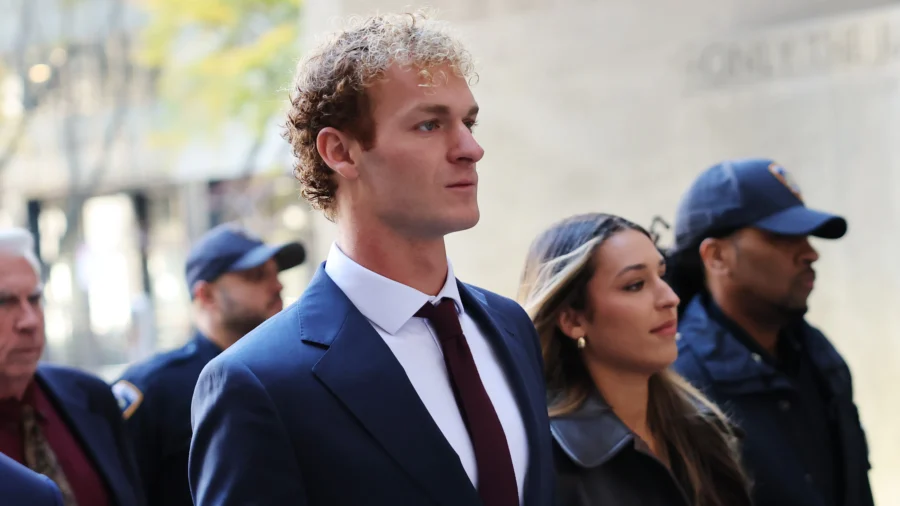NEW YORK CITY—As defense testimony continued in the trial of former Marine Daniel Penny, forensic pathologist Dr. Satish Chundru was called to the witness stand to provide expert testimony on the cause of Jordan Neely’s death on May 1, 2023, on a New York subway.
Chundru explicitly contradicted the testimony of New York City medical examiner Cynthia Harris, who last week stated under oath that it was Penny’s chokehold and not the powerful synthetic cannabinoids she found in Neely’s system during a postmortem examination that was the cause of his death.
“This is not a chokehold death,” Chundru stated under questioning from criminal defense attorney Steven Raiser.
Using medical charts and illustrations of the human anatomy and cellphone video taken at the scene of the incident, Chundru set forth his explanation for what could have caused the death of Neely, who witnesses said was menacing passengers on an uptown F train at Manhattan’s Second Avenue station on May 1, 2023, before Penny stepped in to restrain him using a chokehold. Penny is on trial on charges of manslaughter and criminally negligent homicide related to Neely’s death.
While Harris had stressed the vascular compromise and airway compromise that she said caused an asphyxial death, Chundru instead attributed Neely’s death to a range of factors, including schizophrenia, the drugs in his system, sickle cell disease, and the chokehold. He stipulated that the last factor could not by itself have been lethal.
The expert witness criticized Harris’s approach to analyzing the possible causes of the fatality, saying that a thorough forensic analysis requires careful consideration of all potential factors.
“These are very complicated cases, so you want to make sure you get all the information to make a final decision when you kind of see everything,” Chundru said.
“You want to gather all the information, wait for all the tests to come back, and then go through the process of elimination.”
The witness said that a chokehold death cannot occur without, first, the victim becoming unconscious and, second, consistent pressure on the neck, denying oxygen to the brain and lungs, for a long enough period of time to cause death.
Sickle Cell Complications
Chundru said the body of someone with a sickle cell condition would react differently to stress or pressure from the way a normal person’s body would react.
According to Chundru, in a healthy human body, red blood cells have a round shape and deliver oxygen to the capillaries before making their way back to larger blood vessels.
In the case of someone with sickle cells, the same thing happens in the absence of stress, he said. However, at a heightened level of stress, the cells become sick.
“So now, instead of a round cell, you have a sickle cell. It’s like a crescent moon or a banana shape. They don’t carry oxygen,” the pathologist said. “They start sticking to the blood vessel wall, and they kind of block everything from going forward.”
In the case of Neely, the condition was severe enough for his body to have a highly adverse reaction to the stress of Penny’s hold, Chundru stated.
“He had extensive sickling from the brain tissue all the way down to the kidneys and everything in between. The sickling was in all the blood vessels, and so literally, most of them were blocked.”
Chundru described Neely’s condition as “a sickle cell crisis” in which blood vessels did not deliver oxygen to his tissue cells.
Reviewing cell phone footage showing Neely and Penny lying on the subway car floor with Penny’s arm around Neely’s neck, Chundru disputed prosecution claims that Neely had lost consciousness—a precondition for a chokehold death, according to the definition he had advanced earlier.
Chundru said he believes that at a point in the video when prosecutors maintained Neely had passed out, Neely and Penny were, in fact, still struggling.
“What we notice here is that both of them are very stressed, Mr. Penny is very focused on restraining Mr. Neely, you can see by the facial features of both of them,” he said.
He said that, contrary to the claims of Harris and the prosecutors, Neely did not become unconscious for a sustained period of time prior to his death. Hence, it did not meet the definition of a chokehold death.
Chundru estimated Neely’s death to have occurred four minutes and 30 seconds into the video.
“He never went unconscious before that, which is what you need if it’s a chokehold death,” he said.
Asked what factors he thought were to blame for Neely’s death, Chundru stated, “The combined effects of sickle cell crisis, the schizophrenia, the struggle and restraint, and the synthetic marijuana.”
“Doctor, in your opinion, did Mr. Penny choke Mr. Neely to death on May 1, 2023?” Raiser asked.
“No,” Chundru replied.
On Tuesday, the court heard character witness testimony, when fellow Marines, a friend, and Penny’s mother spoke about the Penny they knew as a person, and there was no technical or forensic discussion of the case. The court was not in session on Wednesday.
The trial resumes on Nov. 22 with further testimony.
From The Epoch Times

